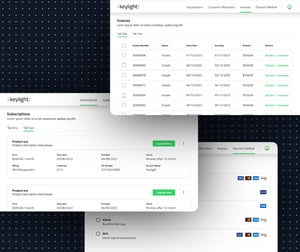The Hidden Value of Customer Self-Service in B2B Businesses | Part two
![]() n our last article we looked at the true meaning of customer self-service in B2B subscription-based businesses and how it facilitates sales revenue growth. In doing so, we established that central to successful customer self-service are systems and processes that are designed for the purpose.
n our last article we looked at the true meaning of customer self-service in B2B subscription-based businesses and how it facilitates sales revenue growth. In doing so, we established that central to successful customer self-service are systems and processes that are designed for the purpose.
However, the business benefits are tangible throughout the customer journey. A truly authentic approach to customer self-service gives businesses a variety of opportunities throughout the sales process and the customer's lifetime. In this article, we are going to explore those opportunities to further benefit your business in the short- and long-term.
Consider customer self-service part of the sales process
We think of customer self-service as a part of the sales process that can enable revenue generation and growth, instead of being a support process or a cost factor, which is typically the mindset many people approach it with.
In our experience, the barriers businesses face to offering customer self-service are:
- The limitations of their own systems
- Fear of losing control of the customer relationship
The first barrier is a practical one to overcome. In an existing organization, it can mean a shift to a new, dedicated, and customizable platform. We have often spoken before about the long-term challenges of trying to adapt legacy platforms that are not designed for subscription businesses, and how they tend to present more rather than fewer issues as time goes on. Once this hurdle is overcome - mentally and practically - the benefits vastly outweigh any concerns, resulting in a more cost-effective approach to business growth, greater business opportunities, and more sustainable business development.
Managing that transition is something that keylight can help you with.
The fear of losing control over the customer relationship is something of a false impression. In reality what you gain is a much healthier relationship with the customer, and far greater insights into their behaviors and needs, which ultimately gives you a stronger link that’s more likely to stand the test of time.
The key is to think about self-service as a two-way engagement with customers - pulling the customer to business instead of pushing them to enter the sales process.
Improving customer relationships through self-service
Giving customers a controlled environment, where they can act autonomously whenever they want, changes the dynamic of your relationship with them. Combined with automation, offering customers self-service options can improve the customer experience and provide business opportunities along the way.
These are opportunities to interact with your customers in a controlled environment, taking a sensitive approach that allows customers to sign up, upgrade and explore their options themselves but in a way that you can monitor, guide, and understand their behaviors to inform next steps or future opportunities. The opportunities tend to hinge on the following parts of the transaction process:
- Shop and checkout flows
- Sign-up forms and login pages
- Dedicated journeys for upgrades, downgrades, add-ons, renewal, pausing and canceling a subscription through the customer portal or a campaign landing page
Self-service actually improves your customer contract
Customers can enter the sales process easily and quickly without needing to wait for a response from a customer service team. If you create an attractive win-back journey as part of the sales process, however, customers also can't leave without giving you the opportunity to find out why and try to change their minds. As the process is fuelled by data and observation of the customer’s behavior, you will be better equipped to meet their needs and win/retain the customer.
Improving customer support
As mentioned, one of the great benefits of customer autonomy in subscription businesses is that it’s data-driven. There are lots of opportunities through which you can learn about and understand your customer by monitoring their actions. For example, page or article analytics with an integrated feedback system can be fed back to product, marketing, and sales to improve customer experience.
This analytical approach and its many touchpoints mean that customer support is no longer reactionary. It allows you to predict customer needs and deliver on them/offer solutions (with possible subscription upgrade opportunities) before you’re asked, thereby improving customer support and your long-term relationship.
Self-service allows for better resource allocation
Lots of businesses think of customer self-service as an opportunity to save money. We prefer to think of it as allowing for better resource allocation. By automating customer self-service strategically and where it’s most effective, you can still nurture customer relationships, including those that are currently less profitable but have the capacity to grow, and reallocate resources upmarket. Often enterprise customers find that they can't sign up for a service by themselves and instead need to contact a sales representative.
The challenges while creating customer self-service
The big thing about customer self-service is that it’s a challenge to do it well. If you don’t do it well then you won’t get the benefits - it will just be a box-checking exercise.
A change of mindset
The first, and possibly most challenging thing, is to move away from the mindset that conflates self-service with losing control of the customer relationship. In reality, it’s quite the opposite. True customer self-service is about knowing your customers better.
In doing so, you accompany customers along their journey with you as whatever they do on your portal or site, you can track, holding their proverbial hand and meeting their needs along the way.
What you do need to consider, however, is how you choose to communicate with your customers in a self-service environment, whether it’s internal messaging, banners, offers, or emails - all of which can be informed by your learnings.
Decoupled systems and adaptability
Decoupled systems are a common issue in subscription-based businesses that don’t use purpose-built platforms and systems. With self-service, however, the problems that come from trying to adapt legacy systems are really exposed and come out in poor customer experience. Typically it means that inconsistent information, timing delays, and incorrect billing can all result as one does not align with another.
For example, recently we came across a situation where a provider made it impossible for the client to upgrade their service themselves, instead of having to phone customer support. As a result of the call, they realized the system had allowed a previous add-on but hadn’t charged for it, and they wanted to back charge. The implication was that the operational systems were disconnected from the billing system, and the net result was a fractured and frustrating customer experience.
Designing a self-service flow for your industry
The needs of customers from one company or industry to the next are not the same, which is why a customizable approach, data and analytics, and predictive capabilities are so important.
Designing a self-service flow that fits your industry or business involves detailed testing. Aligning it with the systems down the line is difficult and usually less effective.
Designing a proper flow filling the expectations of both businesses and customers is important - businesses still need to feel they have control, but so do customers.
Most systems are not flexible enough to make changes quickly or to roll out different solutions for different regions or customer types in a timely manner. This flow is something that systems on the market can’t fulfill because of their decoupled systems. As a result, when businesses build in integrations, there’s always something missing that requires manual input, and that’s where things get messy, expensive, and eventually out of control.

Upgrade from traditional engines
to a robust subscription system
Start now with >keylight/




